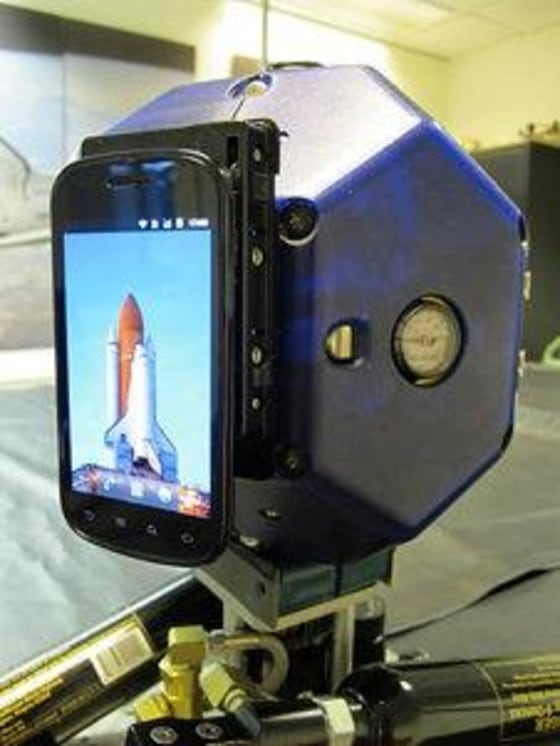The mobile-phone space race has ended in a tie: Last month we found out that NASA's final space shuttle flight was taking a couple of iPhones to the International Space Station, and it turns out that an Android phone was aboard the shuttle Atlantis as well.
The Google-powered Samsung Nexus S phone will be used on the station in a series of experiments aimed at developing free-flying robotic assistants — zero-gravity gizmos that were inspired by the zippy little training sphere that helped Luke Skywalker practice his lightsaber skills in "Star Wars." These volleyball-sized free-fliers are known as SPHERES — which is short for Synchronized Position Hold, Engage, Reorient Experimental Satellites.
SPHERES prototypes have been in the works for more than a decade. The camera-equipped, thruster-driven devices were developed by students at the Massachusetts Institute of Technology in cooperation with the Defense Department and NASA, for possible use as remote-controlled observers in microgravity environments. You could imagine a spyball floating through far-off modules of a space station to make sure all systems were go, during times when the station's human crew is otherwise occupied. Future versions of the device could also look over the shoulder of a spacewalker to give Mission Control an up-close video view of the action.
The beauty part is that the SPHERES prototypes have an expansion port for plugging in extra devices or appendages — and the Samsung Nexus S is the first smartphone to be plugged in.
"By connecting a smartphone, we can immediately make SPHERES more intelligent," D.W. Wheeler, lead engineer in the Intelligent Robotics Group at NASA's Ames Research Center, said in a NASA news release. "With a smartphone, the SPHERES will have a built-in camera to take pictures and video, sensors to help conduct inspections, a powerful computing unit to make calculations, and a Wi-Fi connection that we will use to transfer data in real time to the space station and Mission Control."
Neither the Android phones nor the iPhones are being used to make actual phone calls: Space station residents have special satellite-linked Internet phones for that. But today's smartphones pack so much computing power that they could come in handy as backup navigation devices (in the iPhones' case) or satellite controllers (in the Android phone's case).
"We'll start by simulating a mobile inspection of the station to test how well SPHERES can move around and collect data using the smartphone's camera and sensors," said Terry Fong, director of the Intelligent Robotics Group. "This will tell us basic information about the light and sound levels inside various areas of the station. Then we'll use SPHERES to conduct an interview with a crewmember — a task that usually requires two crew members to complete. We'll have Mission Control and the smartphone-enhanced SPHERES take the place of the astronaut holding the video camera."
Just having the phones on the space station serve as status symbols for the companies involved.
"Samsung is proud to have the Nexus S chosen to be aboard NASA's final space shuttle launch, an event that is historical," Dale Sohn, president of Samsung Mobile, said in the news release. "The research that is being conducted with SPHERES using the Nexus S will help monitor and communicate from the International Space Station."
So what about all the other smartphones and tablets that are out there? Because this is the last shuttle flight, future gizmos will have to be certified for flight on other types of space transports, such as the Russian Soyuz or Progress craft, European and Japanese cargo spaceships, or on commercial vehicles that are currently under development.
The future telecom space race may well be a contest to see which company can extend its calling network to the final frontier. I'm sure there are some future space tourists who'd love to flip on their phone while flying on SpaceShipTwo, call down to their pals and say, "Can you hear me now?" What do you think?
More about phone connections in space:
- iPhone goes to the edge of space
- App tracks shuttle and space station
- Outer space on your phone
- 'Ultimate' cloud comes to the rescue
Connect with the Cosmic Log community by "liking" the log's Facebook page or following @b0yle on Twitter. You can also check out "The Case for Pluto," Alan's book about the controversial dwarf planet and the search for new worlds.
